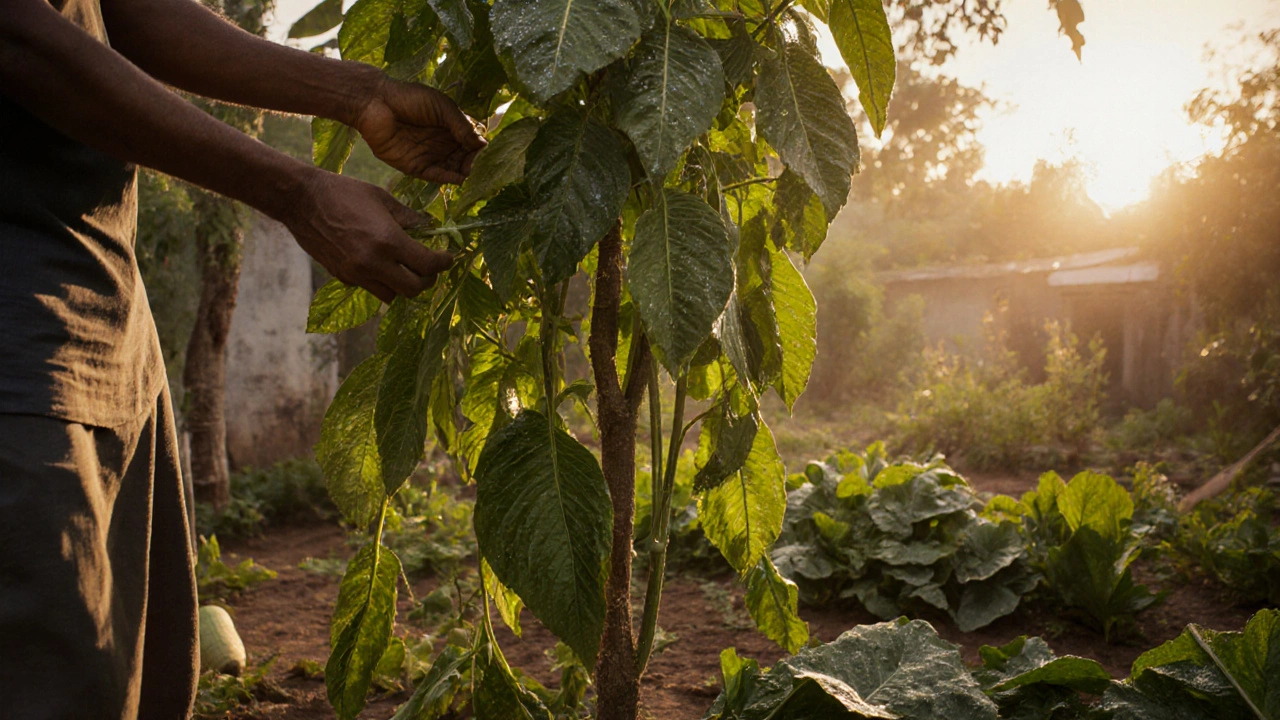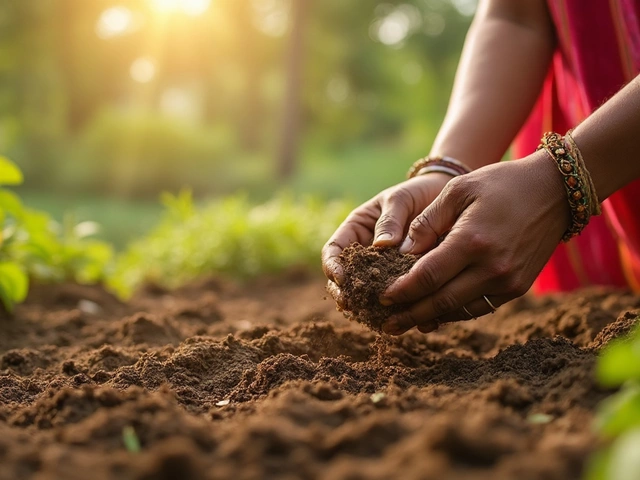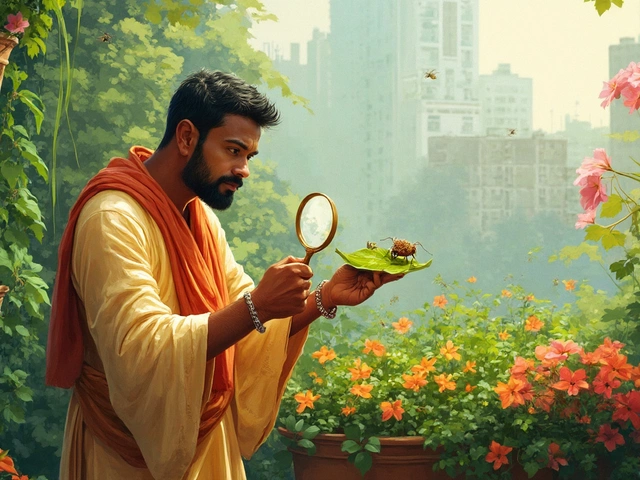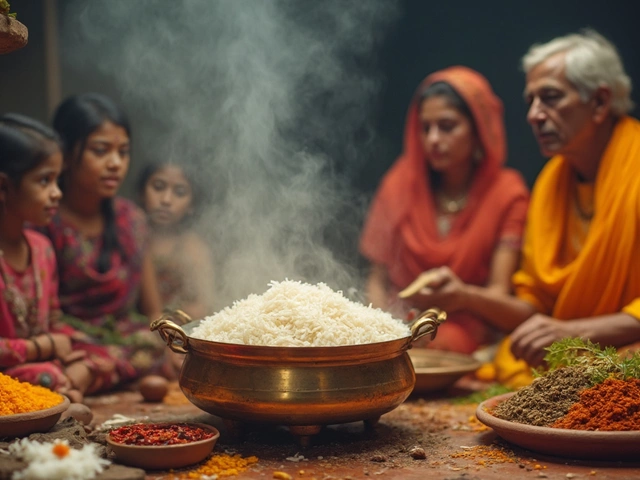Moringa vs Super Veggies Comparison Tool
The nutrition you need depends on your specific health needs. This tool helps you see how moringa compares to other popular vegetables for nutrients that matter most for Indian diets.
Select nutrients to compare:
| Nutrient | Moringa Leaves | Spinach | Kale | Broccoli |
|---|---|---|---|---|
| Protein (g) | 9.4 | 2.9 | 4.3 | 2.8 |
| Calcium (mg) | 185 | 99 | 254 | 47 |
| Iron (mg) | 4.0 | 2.7 | 1.6 | 0.7 |
| Potassium (mg) | 461 | 558 | 348 | 316 |
| Vitamin C (mg) | 51.7 | 28.1 | 120 | 89.2 |
| Fiber (g) | 2.0 | 2.2 | 3.6 | 2.6 |
Why this matters for Indian diets: Moringa leads in protein and iron—two nutrients often lacking in traditional Indian diets. Unlike kale and spinach, moringa's iron is easily absorbed without cooking due to its low oxalate content.
Moringa also provides 15x more potassium than bananas and is rich in essential amino acids—making it a complete protein source.
There’s a myth going around that one vegetable holds the crown as the healthiest vegetable in the world. Kale. Spinach. Broccoli. Brussels sprouts. You’ve heard them all. But here’s the truth: no single vegetable is the ultimate winner. Nutrition doesn’t work like a sports trophy. It’s a team sport. And if you’re looking for the single most powerful plant to grow in your garden-especially if you’re in India, where monsoons shape your planting calendar-then you need to stop chasing rankings and start understanding what your body actually needs.
Why the ‘Healthiest Vegetable’ Question Is Misleading
Every year, some website or influencer declares a new ‘king of veggies.’ They use a scoring system based on vitamins, antioxidants, fiber, and phytonutrients. But here’s the catch: those rankings ignore one big thing-your biology. What’s healthy for a 25-year-old office worker in Mumbai isn’t necessarily the same as what a 60-year-old farmer in Punjab needs. Your age, activity level, gut health, and even your local climate affect what nutrients you absorb best.
Take kale, often crowned the #1 healthiest veggie. It’s packed with vitamin K, calcium, and lutein. Great. But it’s also high in oxalates, which can interfere with calcium absorption if you eat too much. For someone with kidney stones or thyroid issues, that’s a problem. Spinach? Same story. High in iron and folate, but also high in oxalates. Broccoli? Excellent for detox enzymes, but it can cause bloating if your gut isn’t used to cruciferous veggies.
There’s no magic bullet. There’s only balance.
The Real Winner: Moringa (Drumstick Leaves)
If you’re growing vegetables in India-where heat, humidity, and seasonal rains dominate-you need a crop that thrives in tough conditions, grows fast, and delivers more nutrients per gram than almost anything else on earth. That’s moringa.
Moringa oleifera, also called the drumstick tree, is native to the Himalayan foothills and has been used in Ayurveda for over 4,000 years. Its leaves are a nutritional powerhouse:
- 7x more vitamin C than oranges
- 4x more calcium than milk
- 3x more potassium than bananas
- 2x more protein than yogurt
- 15x more potassium than bananas
- Rich in all nine essential amino acids
- Contains quercetin, chlorogenic acid, and other anti-inflammatory compounds
Studies from the Indian Council of Medical Research show moringa leaf powder can reduce blood sugar levels in diabetics and lower LDL cholesterol. In rural areas where malnutrition is common, moringa leaves are dried and ground into flour to fortify rotis and soups. It’s not just healthy-it’s life-saving.
And here’s the kicker: moringa grows like a weed in India. It needs little water, thrives in poor soil, and you can harvest leaves every 30 days. Even in droughts, it survives. No other common vegetable matches its combination of resilience, yield, and nutrient density.
How Moringa Compares to Other ‘Super Veggies’
Let’s put moringa next to the usual suspects. This table shows nutrient content per 100 grams of raw leaves (based on USDA and Indian Food Composition Database):
| Nutrient | Moringa Leaves | Spinach | Kale | Broccoli |
|---|---|---|---|---|
| Calories | 37 kcal | 23 kcal | 49 kcal | 34 kcal |
| Protein (g) | 9.4 | 2.9 | 4.3 | 2.8 |
| Vitamin C (mg) | 51.7 | 28.1 | 120 | 89.2 |
| Calcium (mg) | 185 | 99 | 254 | 47 |
| Iron (mg) | 4.0 | 2.7 | 1.6 | 0.7 |
| Potassium (mg) | 461 | 558 | 348 | 316 |
| Fiber (g) | 2.0 | 2.2 | 3.6 | 2.6 |
Notice something? Moringa doesn’t lead in every category. Kale has more vitamin C. Spinach has more potassium. But moringa leads in protein and iron-two nutrients many Indian diets lack. And unlike kale or spinach, moringa leaves don’t need to be cooked to reduce oxalates. You can eat them raw in salads or blend them into chutneys without worrying about mineral blocking.

Why Moringa Is Perfect for Indian Gardens
If you’re a home gardener in India, you don’t just want nutrition-you want reliability. Moringa fits.
- Grows in 30 days: From seed to harvestable leaves in under a month.
- Drought-resistant: Survives dry spells when other veggies wilt.
- Year-round harvest: In southern India, you can pick leaves every 2-4 weeks.
- Multi-use: Leaves for eating, pods for curry, seeds for water purification.
- Low maintenance: No need for fancy compost or pesticides. It’s naturally pest-resistant.
Many farmers in Tamil Nadu and Andhra Pradesh now plant moringa along field borders. It’s not just a crop-it’s insurance against malnutrition. In urban balconies, it thrives in 12-inch pots. Even in Delhi’s smog, it grows.
How to Grow Moringa in Your Garden
You don’t need a green thumb. Here’s how to get started:
- Get seeds: Buy moringa seeds from local nurseries or online Indian suppliers like Ugaoo or Garden24.
- Plant in warm soil: Sow seeds in late February or March, after the last frost. Soil should be loose and well-draining.
- Space them out: Plant seeds 1-2 feet apart. Moringa grows tall-up to 12 feet.
- Water lightly: Keep soil moist for the first 10 days. After that, water only once a week.
- Harvest early: Start picking leaves when the plant is 3 feet tall. Cut the top 6 inches to encourage bushiness.
- Prune regularly: Every 2 months, trim branches to keep it manageable and promote new growth.
Don’t worry about pests. Moringa rarely gets them. If aphids show up, spray with neem oil. That’s it.
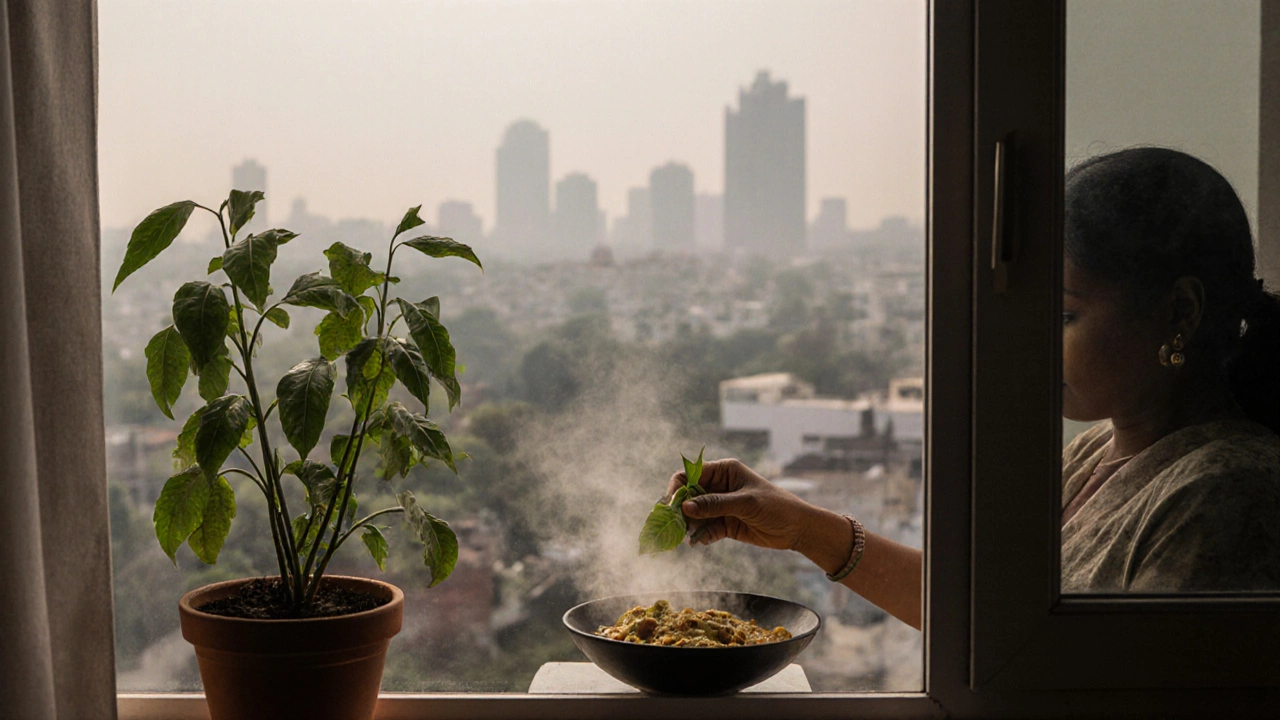
How to Eat Moringa
Don’t let its humble look fool you. Moringa tastes like a cross between spinach and horseradish-earthy, slightly peppery. Here’s how to use it:
- Chutney: Blend fresh leaves with garlic, green chili, and tamarind.
- Curry: Add chopped leaves to dal or sambar in the last 5 minutes of cooking.
- Smoothies: Add a handful to your morning juice with banana and ginger.
- Dried powder: Dry leaves in shade, grind into powder, and add to roti dough or soups.
- Tea: Steep dried leaves in hot water for 5 minutes. Add honey if you like.
Start with small amounts. Too much too fast can cause stomach upset. One cup of fresh leaves daily is plenty.
What About Other Super Veggies?
Moringa isn’t the only great choice. Here’s the real lineup:
- Spinach: Best for folate and iron-but cook it to reduce oxalates.
- Bitter gourd: Excellent for blood sugar control. Bitter, but powerful.
- Amaranth leaves: High in calcium and protein. Grows wild in many parts of India.
- Drumstick pods: The fruit of the moringa tree. Rich in vitamin A and fiber.
- Cluster beans: Low-calorie, high-fiber, and drought-tolerant.
Rotate these in your garden. Don’t plant just one. Mix them. That’s how nature works-and that’s how your body works best.
Final Answer: It’s Not One Vegetable. It’s the Right One for You.
The healthiest vegetable isn’t the one with the most hype. It’s the one you can grow, eat regularly, and that fits your body’s needs. For most people in India, that’s moringa. It’s not just nutritious. It’s practical. Accessible. Sustainable. And it doesn’t need a greenhouse or imported seeds.
Grow moringa. Eat it. Share it. Your body-and your garden-will thank you.
Is moringa safe to eat every day?
Yes, moringa leaves are safe for daily consumption in moderate amounts. Most studies use 1-2 teaspoons of dried powder or 1 cup of fresh leaves per day. Avoid excessive intake if you’re pregnant or on thyroid medication, as moringa can affect hormone levels in very high doses.
Can I grow moringa in a pot on my balcony?
Absolutely. Moringa thrives in containers as small as 12 inches wide. Use a pot with drainage holes and fill it with sandy loam soil. Place it in full sun. Water once a week. Prune the top regularly to keep it under 4 feet tall. You’ll get fresh leaves all year in warm climates.
How does moringa compare to spinach for iron absorption?
Moringa has more iron per gram than spinach (4mg vs 2.7mg), and it contains vitamin C, which helps your body absorb iron better. Spinach has oxalates that block iron absorption unless cooked. Moringa doesn’t have the same level of oxalates, so its iron is more bioavailable-even raw.
Does moringa help with diabetes?
Yes. Multiple clinical studies, including one published in the Journal of Diabetes Research, show moringa leaf extract can lower fasting blood sugar and improve insulin sensitivity. It’s not a replacement for medication, but it’s a powerful dietary support for managing type 2 diabetes.
Where can I buy moringa seeds in India?
You can find moringa seeds at local nurseries in states like Karnataka, Tamil Nadu, and Uttar Pradesh. Online, trusted sources include Ugaoo, Garden24, and Amazon India (look for ‘Moringa oleifera’ seeds). Avoid generic ‘drumstick seeds’-make sure the scientific name is listed.
